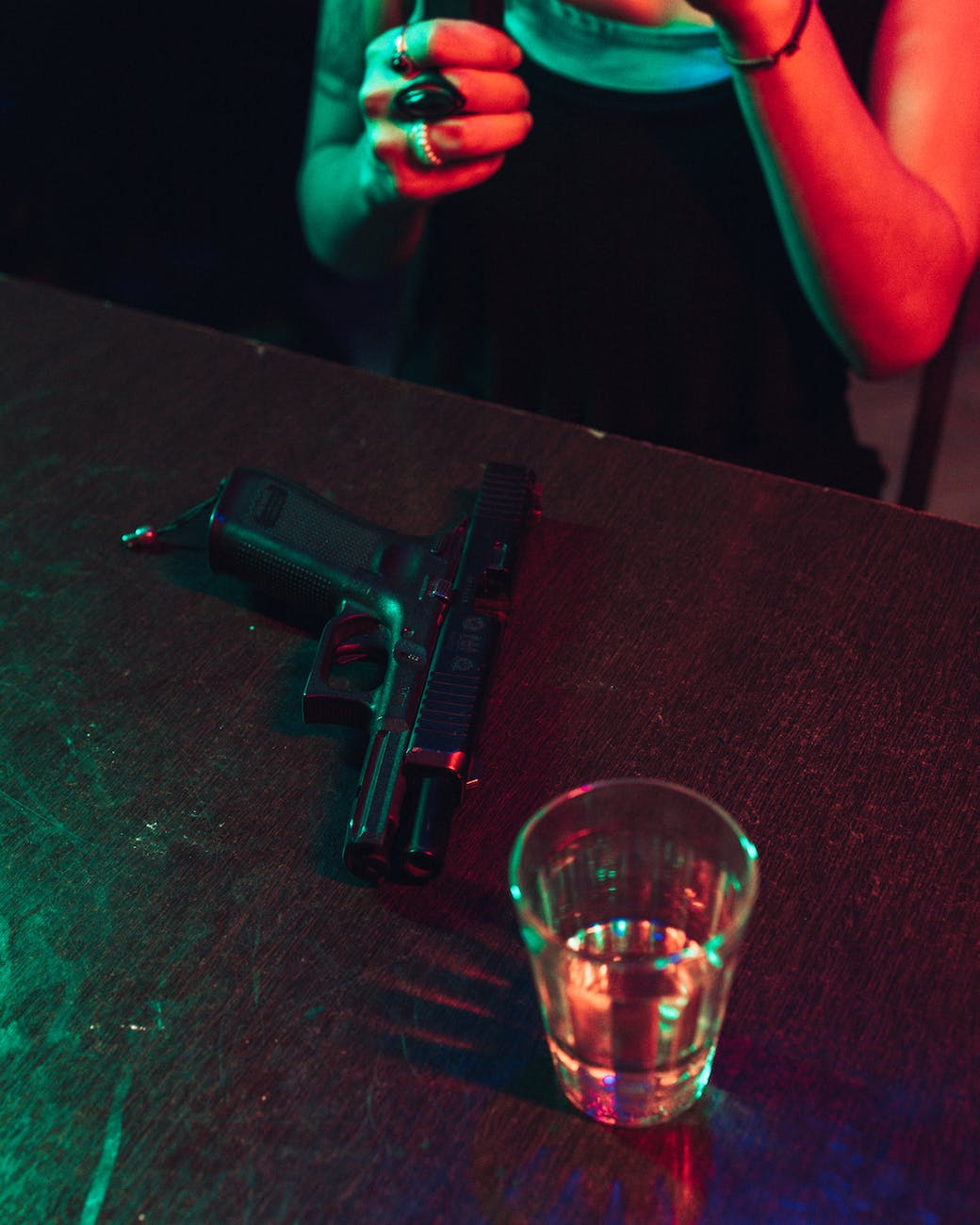Tension Roulette
The Game of tension

In an exploration of games to teach tension and suspense, I thought back to movies that had great moments of tension. The movie that came to mind was one that I saw in an old artsy movie theatre in Montreal called THE DEER HUNTER. The Oscars for Best Picture, Director, and Supporting Actor are well deserved.
There are THREE Russian Roulette scenes that have viewers on the edge of their seats or covering their eyes. In one scene between the characters played by Robert De Niro and Christopher Walken, the promise of a single bullet firing in this horrible game and the consequences of what MUST happen seems to go on forever and still creates tension after knowing the outcome. (If you are able to handle that sort of tension, watch this clip of DeNiro and Walken forced to play the game for the enemy’s entertainment.)
Creating tension and suspense is useful for improvised scenes. While the tension in The Deer Hunter is violent, not all tension and suspense have to be that way. Let’s take a look at 3 ways to play Tension Roulette.
GAME: TENSION ROULETTE
ORIGIN: Shawn
BENEFITS:
- Remove control from performers,
- create Tension/Suspense,
- Make and keep promises,
- Adapt to the unknown, and
- Practice reaction.
# PEOPLE: 3
GOAL: Strong promises are made in the setup of the scene. No one knows who will have to fulfill the promise but when it happens, performers have to justify why.
PROCEDURE:
VERSION 1 of 3 – TENSION ROULETTE
- In version one of this game, Prepare 7 pieces of paper. ALL but two slips of paper are blank. The two remaining slips of paper have strong OPPOSING promises announced to everyone: “FALL IN LOVE” on one slip “LEAVE FOREVER” on the other. “MURDER”, on one slip, “PROPOSE” on the other… etc. All slips of paper are folded and placed in a box on a chair at the corner of the stage.
- The performers are told that they must first establish a scene with a good platform (a strong variety of details – generally not negative, No conflict, defined relationships.).
- With the platform set, the scene continues with any player taking a slip of paper and looking at it so no one knows what’s on it except for that performer.
- The scene moves forward.
- If your paper has instructions, you should do what it says soon. THEN justify why.
- If the other performers are satisfied that there’s nothing on the first performer’s paper, then they can take a slip of paper one after the other as the scene continues. (Never make reference to the slips of paper or the box). Just take a slip of paper without announcing it as the scene goes forward.
- If another player is about to take a piece of paper and yours has instructions, you must fulfill what’s on that paper immediately.
EXAMPLE:
- Tom, Guido and Jenna get the suggestions of MURDER and MARRY (very differing suggestions) which are seperatly written onto 2 of the 7 pieces of paper, and placed in the box at the corner of the stage.
- The performers create a solid opening platform establishing themselves as foreign scientists of 3 nationalities collaborating at the University of Geneva in the physics department. We learn interesting things about them and their connection. The platform is set (not hinting towards Murder or Marriage).
- Tom casually takes a slip of paper from the box while they set up the experiment for laser diffraction. (or whatever physicists do). Tom smiles and we aren’t sure what is about to happen but the audience is reading something in his behaviour… or so they think.
- The scene moves forward until Guido grabs a slip of paper. Because he believes there was nothing on Tom’s paper.
- Without warning Guido (who has pulled the MURDER suggestion) turns the laser towards Tom, then yells at the other scientist who is screaming over the dead body., He redirects the laser toward her. OF COURSE, she has to ask why he’s doing this. His justification comes out of the platform earlier. His government can’t allow for the laser experiment to succeed.
- The promise of the scene has been fulfilled and now the final outcome has to be played out. Will Guido kill Jenna or will there be revenge?
VARIATION:
VERSION 2 — HIDDEN SUGGESTION ROULETTE
In the first version there are 2 options possible on 7 pieces of paper. This leaves uncertainty until the choice is revealed. In the second version, we play with just one suggestion on one of five pieces of paper.
Performers are asked to leave the stage and ONE strong outcome/theme is created (from the director or audience). We all know the suggestion is that a KISS will happen in the scene.
The scene continues as before. One at a time they alternate removing slips of paper and fulfilling the promise. (or taking another slip if they feel their partner has nothing) In this version, you can continue taking paper slips EVEN IF YOU HAVE ALREADY TAKEN THE INSTRUCTION SLIP. But do so only if you feel that by doing so, you are raising tension.
VERSION 3 — “Fuck – Marry – Murder” Roulette
(2 – 5 players) Do you remember the game “Fuck – Marry – Murder”? Apologies to those who feel offended by that word… (Yes, Marry is an offensive word).
In that juvenile game, you are given three names of people you all know. You must answer Who you would Marry, Who you would have sex with, and Who you would kill. WHAT A HORRIBLE GAME!!! (I’ve seen Improvisers play this for hours, cringing and agonizing while justifying their choices.
In this third variation of TENSION ROULETTE, the scene starts as before with a grounded platform. There are 6 pieces of paper. On 3 slips of paper, there is written one of the 3 possibilities – FUCK MARRY MURDER.
Everyone can take a slip of paper BEFORE the scene starts and place it in their pocket. When there is consensus (without talking about it) that the platform is well-established. People can look at what’s on their slip of paper.
The suggestions on the slips of paper can’t be fulfilled until everyone has seen their paper.
AND NOOOOO… you don’t have to DO that first suggestion on stage. And NOOOOO You don’t have to DO IT BACKSTAGE!! Fulfill your intention. Try to get the person to go with you into the bedroom, etc etc… Sheeesh!
TEACHING TIPS:
Justifications are important BUT there’s a difference between justifying FIRST and then DOING something or DOING something first and then justifying. It’s much more dangerous and fun to act without knowing why and then justifying later. Leap NOW and discover if you have a parachute after.
Also, the justification should come from the details you created in the platform of the scene. If you are struggling to find reasons for your action, there’s a good chance your platform lacked detail, had conflict or had little variation.
Of course, you can get suggestions from the audience for the slips of paper but unless the suggestions have some ‘value’ then there will be no tension or interest in the game.
WEAK SUGGESTIONS:
- Jump up and down
- Explain how to cook a steak
- fart
- Make cookies
STRONGER SUGGESTIONS:
- Express your love
- Murder
- Leave forever
- Steal something of value
- Ask your partner to surrogate a child for you/donate an organ
The third person is important in some scenes as a sort of sounding board for the audience. Having someone as the passenger in the scene allows for the observer’s reaction which resonates with the audience. It also helps to create tension. A fight with a parent is more tense when a romantic partner is in the room. A murder has added tension when a witness is watching.




0 Comments